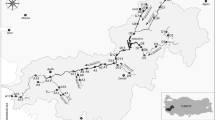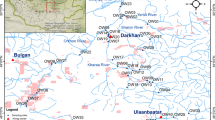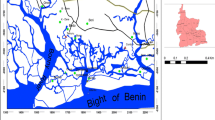Abstract
A 4-year study (1972–1976) determined long-term trends of organochlorine residues (DDT, DDE, DDD, PCB's, mirex) and trawl-susceptible organisms in a shallow, river-dominated estuary in North Florida (Apalachicola Bay, USA). Moderate levels of such compounds were found in various species prior to the restricted use of DDT in 1972. A subsequent precipitous decline in organochlorine besidues was attributed to decreased upland usage, major flushing of the river basin in early 1973, and various factors associated with estuarine function. No mirex was found in sediments or aquatic organisms. Apparently, the half-life of organochlorines is relatively short in this bay system. Various statistical methods were used to test the relationships of different physico-chemical and biological parameters. During the 4-year study period, seasonal river flow fluctuations dominated water color, turbidity, salinity, nutrients (NO3), chlorophyll a, and the temporal succession of fishes in the bay. Certain long-term trends of fish associations were noted; relative dominance of key fish species declined and stabilized while bay-wide species richness and diversity increased with time. Qualitative changes in species representation determined the long-term pattern of community variability. This was consonant with a distinctive fish fauna during the first year of sampling. The bay anchovy Anchoa mitchilli was dominant during 9 of the first 12 monts of the project; this influenced the time-related changes in community indices. Temporally clustered fish associations reflected the importance of river flow in the estuarine environment. Direct correlation of fish distribution with the rapid disappearance of organochlorine compounds was complicated by aperiodic natural phenomena such as storms and river fluctuations. Population and community trends appeared consistent with other studies showing similar patterns of dominance of stress-resistant fish populations and related changes in community parameters. In this case, the relatively predictable annual succession of fish associations allowed an appraisal of key forcing functions. Due to the high level of seasonal and annual biological variability in this estuary, there were some problems in the application of linear statistical models to the data base. Although the long-term trend of relative species representation is useful as an index of stress, new techniques are needed to analyze extensive field data so that functions such as trophic interactions are included in the estimation of causal relationships. There are indications that such effects could be related to the impact of organochlorine compounds on estuarine systems.
Similar content being viewed by others
Literature Cited
Bechtel, T.J. and B.J. Copeland: Fish species diversity indices as indicators of pollution in Galveston Bay, Texas. Contr. mar. Sci. Univ. Tex. 15, 103–132 (1970)
Berger, W.H. and F.L. Parker: Diversity of planktonic Foraminifera in deep-sea sediments. Science, N.Y. 168, 1345–1347 (1970)
Biomedical Computer Programs: 3rd ed. 773 pp. Ed. by W.J. Dixon. Berkeley & Los Angeles: University of California Press 1973
Bittaker, H.F.: A comparative study of the phytoplankton and benthic macrophyte productivity in a polluted versus unpolluted coastal area, 174 pp. M.S. Thesis, Florida State University, Tallahassee 1975
Boesch, D.F.: Classification and community structure of macrobenthos in the Hampton Roads area, Virginia. Mar. Biol. 21, 226–244 (1973)
Bradshaw, J.S., E.L. Loveridge, K.P. Rippee, J.L. Peterson, D.A. White, J.R. Barton and D.L. Fuhriman: Seasonal variations in residues of chlorinated hydrocarbon pesticides in the water of the Utah Lake drainage system — 1970 and 1971. Pestic. Monit. J. 6, 166–170 (1972)
Breidenbach, A.W., C.G. Gunnerson, K.F. Kawahara, J.J. Leichtenberg and R.S. Green: Chlorinated hydrocarbon pesticides in major river basins, 1957–65. Publ. Hlth Rep., Wash. 82, 139–156 (1967)
Brodtmann, N.V., Jr.: Continuous analysis of chlorinated hydrocarbon pesticides in the lower Mississippi River. Bull. envir. Contam. Toxicol. 15, 33–39 (1976).
Brongeersma-Sanders, M.: Mass mortality in the sea. Mem. geol. Soc. Am. 67, 941–1010 (1957)
Butler, P.A.: Monitoring pesticide pollution. BioSci. 19, 889–896 (1969)
— Organochlorine residues in estuarine mollusks, 1965–72 National Pesticide Monitoring Program. Pestic. Monit. J. 6, 238–363 (1973)
Copeland, B.J. and T.J. Bechtel: Species diversity and water quality in Galveston Bay, Texas. wat. Air Soil Bollut. 1, 89–105 (1971)
Croker, R.A. and A.J. Wilson: Kinetics and effects of DDT in a tidal marsh ditch. Trans. Am. Fish. Soc. 99, 152–159 (1970)
Dahlberg, M.R. and E.P. Odum: Annual cycles of species occurrence, abundance, and diversity in Georgia estuarine populations. Am. Midl. Nat. 83, 382–392 (1970)
Dawson, C.E., Jr.: A contribution to the hydrography of Apalachicola Bay, Florida. Publs Inst. mar. Sci. Univ. Tex. 4, 13–35 (1955)
Duke, T.W. and D.P. Dumas: Implications of pesticide residues in the coastal environment. In: Pollution and physiology of marine organisms, pp 137–164. Ed. by F.J. Vernberg and W.B. Vernberg. New York: Academic Press 1974
Fisher, N.S.: Chlorinate hydrocarbon pollutants and photosynthesis of marine phytoplankton: a reassessment. Science, N.Y. 189, 463–464 (1975)
Giam, C.S., A.R. Hanks, R.L. Richardson, W.M. Sackett and M.K. Wong: DDT, DDE, and polychlorinated biphenyls in biota from the Gulf of Mexico and Caribbean Sea — 1971. Pestic. Monit. J. 6, 139–143 (1972)
Haedrich, R.L. and S.O. Haedrich: A seasonal survey of the fishes in the Mystic River, a polluted estuary in downtown Boston, Massachusetts. Estuar. cstl mar. Sci. 2, 59–73 (1974)
Harrington, R.W. and W.L. Bidlingmayer: Effects of dieldrin of fishes and invertebrates of a salt marsh. J. Wildl. Mgmt 22, 72–76 (1958)
Henderson, C., A. Inglis and W.L. Johnson: Organochlorine insecticide residues in fish—fall 1969. National Pesticide Monitoring Program. Pestic. Monit. J. 5, 1–11 (1971)
Johnson, D.W.: Pesticides and fishes — a review of selected literature. Trans. Am. Fish. Soc. 97, 398–424 (1968)
Johnston, D.W.: Decline of DDT residues in migratory songbirds. Sciences, N.Y. 186, 841–842 (1974)
Livingston, R.J.: Field and laboratory studies concerning the effects of various pollutants on estuarine and coastal organisms with application to the management of the Apalachicola Bay System (North Florida, USA). Final Report, State University System of Florida. Sea Grant SUSFSG-04-3-158-43 (Unpublished), 1974. (Copies available from Florida Sea Grant Program, Gainesville, Florida, USA)
—: Impact of kraft pulp-mill effluents on estuarine and coastal fishes in Apalachee Bay, Florida, USA. Mar. Biol. 32, 19–48 (1975)
—: Dynamics of organochlorine pesticides in estuarine systems: effects on estuarine biota, In: Estuarine processes, Vol. 1. pp 507–522. Ed. by M. Wiley. New York: Academic Press 1976a
—: Diurnal and seasonal fluctuations of estuarine organisms in a north Florida estuary. Estuar. cstl mar. Sci. 4, 373–400 (1976b)
—, R.L. Iverson, R.H. Estabrook, V.E. Keys and J. Taylor, Jr.: Major features of the Apalachicola Bay system: physiography, biota, and resource management. Fla Scient. 37, 245–271 (1974)
Livingston, R.J. R.L. Iverson and D.C. White: Energy relationships and the productivity of Apalachicola Bay. Final Report, State University System of Florida Sea Grant, SUSFSG-R/EM-4 (Unpublished), 1977a (Copies available from Florida Sea Grant Program, Gainesville, Florida, USA)
— G.J. Kobylinski, F.G. Lewis, III and P.F. Sheridan: Long-term fluctuations of epibenthic fish and invertebrate populations in Apalachicola Bay, Florida. Fish. Bull. U.S. 74, 311–321 (1976)
—, P.F. Sheridan, B.G. McLane, F.G. Lewis, III and G.J. Kobylinski: The biota of the Apalachicola Bay System: functional relationships. In: Proceedings of the Conference on the Apalachicola Drainage System, pp 75–100. Ed. by R.J. Livingston and E.A. Joyce, Jr. St. Petersburg, Fla.: Florida Department of Natural Resources, Marine Research Laboratory 1977b. (Fla mar. Res. Publs No. 26)
MacGregor, J.A.: Changes in the amount and proportions of DDT and its metabolites, DDE and DDD, in the marine environment off southern California, 1949–72. Fish. Bull. U.S. 72, 275–293 (1974)
Margalef, D.R.: Information theory in ecology. Gen. Syst. 3, 36–71 (1958)
Matusita, K.: Decision rules based on the distance for problems of fit, two samples and estimation. Ann. math. Statist. 26, 631–640 (1955)
McErlean, A.J., S.G. O'Conner, J.A. Mihursky and C.I. Gibson: Abundance, diversity, and seasonal patterns of estuarine fish populations. Estuar. cstl mar. Sci. 1, 19–36 (1973)
McNaughton, S.J.: Structure and function in California grasslands. Ecology 49, 962–972 (1968)
Mosser, J.L., N.S. Fisher and D.F. Wurster: Polychlorinated biphenyls and DDT alter species composition in mixed cultures of algae. Science, N.Y. 176, 533–535 (1972)
—, T.C. Teng, W.G. Walter and C.F. Wurster: Interactions of PCB's, DDT, and DDE in a marine diatom. Bull. envir. Contam. Toxicol. 12, 665–668 (1974)
Nisbet, I.C.T. and A.F. Sarofim: Rates and routes of transport of PCB's in the environment. Envir. Hlth Perspectives (exp. Iss.) 1, 21–38 (1972)
Oviatt, C.A. and S.W. Nixon: The demersal fish of Narragansett Bay: an analysis of community structure, distribution, and abundance. Estuar. cstl mar. Sci. 1, 361–379 (1973)
Peakall, D.B. and J.L. Lincer: Polychlorinated biphenyls — another life-long widespread chemical in the environment. BioSci. 20, 958–964 (1970)
Pielou, E.C.: Shannon's formula as a measure of specific diversity: its use and misuses. Letters to the editors. Am. Nat. 100, p. 914 (1966a)
—: The measurement of diversity in different types of biological collections. J. theor. Biol. 13, 131–144 (1966b)
—: The use of information theory in the study of the diversity of biological populations. Proc. Berkeley Symp. math. Statist. Probab. 4, 163–177 (1967)
—: An introduction to mathematical ecology, 286 pp. New York: Wiley-Interscience 1969
Richard, J.R., G.A. Junk, M.J. Avery, N.L. Nehring, J.S. Fritz and H.J. Svec: Analysis of various Iowa waters for selected pesticides: atazine, DDE, dieldrin — 1974. Pestic. Monit. J. 9, 117–123 (1975)
Robins, C.R.: Effects of storms on the shallow-water fish fauna of southern Florida with new records of fishes from Florida. Bull. mar. Sci. Gulf Caribb. 7, 266–275 (1957)
Shannon, C.E. and W. Weaver: The mathematical theory of communication, 166 pp. Urbana: University of Illinois Press 1963
Simpson, E.H.: Measurement of diversity. Nature, Lond. 163, p. 688 (1949)
Smith, R.M. and C.E. Cole: Chlorinated hydrocarbon insecticide residues in winter flounder, Pseudopleuronectes americanus. J. Fish. Res. Bd Can. 27, 2374–2380 (1972)
Sneath, P.H.A. and R.R. Sokal: Numerical taxonomy, 573 pp. San Francisco: W.H. Freeman Co. 1973
Statistical Package for the Social Sciences: 2nd ed. 675 pp. New York: McGraw-Hill Book Co. 1975
Tabb, D.C. and A.C. Jones: Effect of Hurricane Donna on the aquatic fauna of north Florida bay. Trans. Am. Fish. Soc. 91, 375–378 (1962)
Thompson, N.P., P.W. Rankin and D.W. Johnston: Polychlorinated biphenyls and p, p'-DDE from Ascension Island, South Atlantic Ocean. Bull. envir. Contam. Toxicol. 11, 339–406 (1974)
Van Belle, B. and I. Ahmad: Measuring affinity of distributions. In: Reliability and biometry: statistical analysis of lifelength, pp 1–18. Ed. by F. Proschan and R.J. Serfling. Tallahassee: Florida State University Press 1973
Walsh, G.E.: Insecticides, herbicides, and polychlorinated biphenyls in estuaries. J. Wash. Acad. Sci. 62, 122–139 (1972)
Wershaw, R.L., P.L. Burcar and M.C. Golberg: Interaction of pesticides with natural organic material. Envir. Sci. Technol. 3, 271–273 (1969)
White, D.H.: Nationwide residues of organochlorines in starlings, 1974. Pestic. Monit. J. 10, 10–17 (1976)
Wilson, A.J.: Effects of suspended material on measurement of DDT in estuarine water. Bull. envir. Contam. Toxicol. 15, 515–521 (1976)
Zimmerman, M.S. and R.J. Livingston: The effects of kraft mill effluencts on benthic macrophyte assemblages in a shallow-bay system (Apalachee Bay, North Florida, USA). Mar. Biol. 34, 297–312 (1976)
Author information
Authors and Affiliations
Additional information
Communicated by M.R. Tripp, Newark
Rights and permissions
About this article
Cite this article
Livingston, R.J., Thompson, N.P. & Meeter, D.A. Long-term variation of organochlorine residues and assemblages of epibenthic organisms in a shallow North Florida (USA) estuary. Mar. Biol. 46, 355–372 (1978). https://doi.org/10.1007/BF00391408
Accepted:
Issue Date:
DOI: https://doi.org/10.1007/BF00391408




